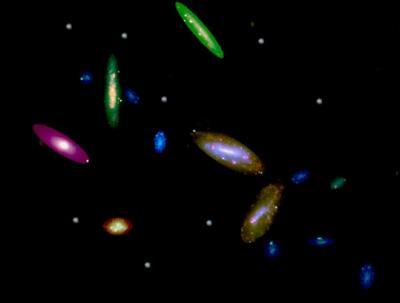New observations from Tel Aviv University may be giving new strength to this theory. A team led by Dr. Noah Brosch, Director of the Tel Aviv University-owned Wise Observatory, say they have uncovered what they believe are visible traces of a "filament" of dark matter –– an entity on which galaxies meet, cluster and form. A filament can originate at the junction of two "soap bubbles," where the thin membrane is thicker.
 The picture shows the 14 galaxies studied at the Wise Observatory. The galaxies stretch along a line from the lower-right to the top-left corner of the image. The star-forming regions are highlighted as shining reddish points. (Photo Credit: AFTAU)
The picture shows the 14 galaxies studied at the Wise Observatory. The galaxies stretch along a line from the lower-right to the top-left corner of the image. The star-forming regions are highlighted as shining reddish points. (Photo Credit: AFTAU)Dr. Brosch, with his M.Sc. student Adi Zitrin and researchers from Cornell University, studied an area of the sky opposite the constellation Virgo, where 14 galaxies were forming in a line. Pundits have called the line a "Bridge to Nowhere" because it seems to start and end in unknown locations. Strangely, 13 of these galaxies were simultaneously giving birth to new stars.
"A Hair on the Beard of the Creator"
The odds of this occurrence are very rare, leading the researchers to believe that the galaxies might somehow be forming on this elusive filament, made entirely from dark matter, which attracts regular matter that then turns into new stars. "There has long been a theoretical belief that this was the case," says Dr. Brosch, "but this new finding represents experimental results that such a filament really exists, and that possibly it is an entity made from dark matter which is aligning these galaxies."
Dr. Brosch compares the work of an astronomer to "looking for hairs of the beard of the Creator."
This line of galaxies may be one such hair. Generally speaking, matter as we know it on earth makes up only a small percentage of our universe. The composition of most of the universe is unknown ― it's either dark matter (about one quarter of the universe) or dark energy (the other three-quarters). "Our studies show that you don't need to go to the edge of the universe to find dark matter. It may be only 15 million light years away, more or less in our backyard," says Dr. Brosch.
The research has massive implications for astronomy and the understanding of galaxy-formation. And due to the surprising closeness of this new grouping of galaxies to ours, it would only be a matter of technological advances ― maybe a couple of hundred years ― and a longer human lifespan before explorers could visit this unusual dark matter in person. "Our technology is abysmally limited right now, but it could definitely happen," says Dr. Brosch.




Comments